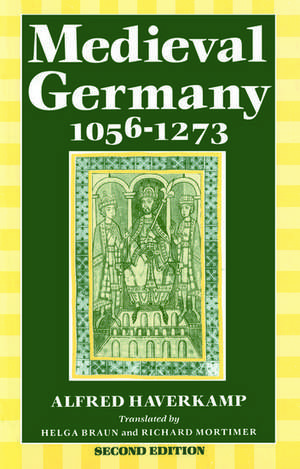Medieval Germany 1056-1273
Autor Alfred Haverkamp Traducere de Helga Braun, Richard Mortimeren Limba Engleză Paperback – 26 aug 1992
Preț: 339.79 lei
Preț vechi: 413.79 lei
-18% Nou
Puncte Express: 510
Preț estimativ în valută:
65.03€ • 67.64$ • 53.68£
65.03€ • 67.64$ • 53.68£
Carte tipărită la comandă
Livrare economică 04-10 aprilie
Preluare comenzi: 021 569.72.76
Specificații
ISBN-13: 9780198221722
ISBN-10: 019822172X
Pagini: 440
Ilustrații: 1 map, 1 genealogical table
Dimensiuni: 138 x 216 x 25 mm
Greutate: 0.56 kg
Ediția:2
Editura: OUP OXFORD
Colecția OUP Oxford
Locul publicării:Oxford, United Kingdom
ISBN-10: 019822172X
Pagini: 440
Ilustrații: 1 map, 1 genealogical table
Dimensiuni: 138 x 216 x 25 mm
Greutate: 0.56 kg
Ediția:2
Editura: OUP OXFORD
Colecția OUP Oxford
Locul publicării:Oxford, United Kingdom
Cuprins
Notes on References; Introduction; I. The Age in European Perspective: 1. The Expansion of the West in the Mediterranean Area; 2. The Spread of Latin Christendom in Continental Europe; 3. The Creation of New Kingdoms and Forms of Lordship; 4. Population Increase, Settlement Density, and Economic Growth; 5. Poverty, Penitence, and Heresy; 6. The Papacy, the Church, and Monasticism; 7. Education and Learning; 8. Social Change; 9. Typology and Transmission of Sources; II. Germany from the Middle of the Eleventh to the Middle of the Twelfth Century: Tradition and Change: 1. Imperial Rule from Henry III to Barbarossa (1056-1152); 2. The Power Structure and its Evolution; 3. The Badis and Development of the Economy; 4. The Church, Piety, and Education; 5. Groups and Communities in Transformation; III. Germany Under the Staufen: New Forms and Limitations: 1. Imperial Rule in the Staufen Period; 2. Continuity and Change in Lordship; 3. The Expansion of the Economy; 4. Church Life, Piety, and Education; 5. New Beginnings in the Social System; IV. Germany in the Context of Europe; Bibliography; Index; Map.
Recenzii
`Haverkamp's range is far wider than that offered in other works ... This book deserves to become the standard text in English for students of Germany in the central Middle Ages.' Journal of Medieval History
`a very welcome addition ... It is solid, reliable, and contains many details which normally escape the textbook' Julia Barrow, VCH of Cheshire, History
`a very welcome addition ... It is solid, reliable, and contains many details which normally escape the textbook' Julia Barrow, VCH of Cheshire, History














